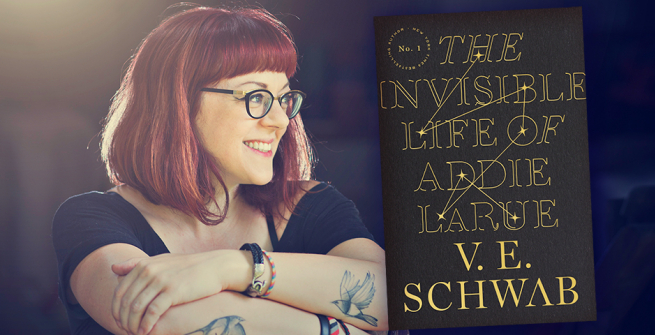Victoria “V. E.” Schwab is the #1 New York Times bestselling author of more than twenty books, including the acclaimed Shades of Magic series (A Darker Shade of Magic, A Gathering of Shadows, A Conjuring of Light), Villains series (Vicious, Vengeful), Monsters of Verity duology (This Savage Song, Our Dark Duet), and the Cassidy Blake series (City of Ghosts, Tunnel of Bones). Her work has received critical acclaim, been translated into more than two dozen languages, and has been optioned for television and film. When she’s not haunting Paris streets or trudging up English hillsides, she lives in Edinburgh, Scotland, and is usually tucked in the corner of a coffee shop, dreaming up monsters. The Invisible Life of Addie LaRue is her latest novel and she recently talked about it with Daryl Maxwell for the LAPL Blog.
What was your inspiration for The Invisible Life of Addie LaRue?
Sometimes inspiration is a single seed that grows a tree, but most often for me, it’s ingredients in a meal. It’s many things, drawn together into something cohesive. I was inspired by Peter Pan and the loss of memory, by my own grandmother’s dementia and the way my mother watched herself being erased from her memory, by the classic depictions of Faustian bargains and the idea that men and women move through the world differently, and are afforded different space, by the promise of forever, and what it means to leave a mark.
Are Addie, Luc, Henry, or any of the other characters in the novel inspired by or based on specific individuals?
I never base a fictional character on a real person, lest I feel allied to the inspiration instead of the creation, but I do absolutely take pieces of myself—my fear, anxiety, hope, longing, ambition—and inject them into characters. In that way, Henry is the closest thing to based on a person, but that person is me, or at least, who I would have been if I hadn’t found writing.
How did the novel evolve and change as you wrote and revised it? Are there any characters or scenes that were lost in the process that you wish had made it to the published version?
Well, I first had the beginnings of the idea when I was 23, and I finished the book when I was 32, so the remarkable thing is that not only did the story shift and grow over time but so did I. The characters changed, their motivations and fears honed into sharp relief by my own growth, the story deepening from an immortality tale to an examination of time and longing and fear and inspiration. As for things lost, no, in fact, things were lost between idea and first draft, but over the course of revision, the story found its way. I can honestly say the finished book is the closest I’ve ever managed to an idea in my head.
The novel spans the hundreds of years of Addie’s life. Did you have to do a lot of research on the 18th through 21st centuries to tell the story you wanted to tell? If so, what is the most interesting or surprising thing that you learned during your research?
I did both historical research and geographic research, meaning I traveled to every place I wrote about, and many places that ended up not playing a part on the page. I knew I wanted to graze history, but also that Addie’s interest would be less geopolitical and more art. I will say, even though I never got to spend very long in any time/scene, I was fascinated by the composition of the salons in Paris in the mid-to-late 1700s, and the role of women in fostering those intellectual communities.
If you could, would you want to live during one of the periods through which Addie lives? If so, which one? Why that one?
Every time has its advantages and disadvantages, especially for a woman (and even then, Addie had the massive privilege, like me, of being white). Those restrictions on female autonomy aren’t the most appealing, but I will say, I’ve always wondered about the world’s fairs, the age of art and invention. I would have loved to see the first Ferris Wheel, or the glass plazas full of new ideas, or the Eiffel Tower when it was debuted.
What’s currently on your nightstand?
I’m currently reading The Mothers by Brit Bennett after devouring The Vanishing Half. After that I have Juliet Takes a Breath by Gabby Rivera and Big Friendship by Aminatou Sow and Ann Friedman.
What is the question that you’re always hoping you’ll be asked, but never have been? What is your answer?
Hah, honestly I don’t know! In that, I feel like I’ve been asked every question under the sun, so I’m waiting now to be surprised by one I haven’t. :p
What are you working on now?
Right now I’m working on several short stories, a novel I’m calling Secret Garden meets Crimson Peak, a new comic book series set in the Villains world called ExtraOrdinary, and the next book in the Shades of Magic series. No rest for the wickedly ambitious!

